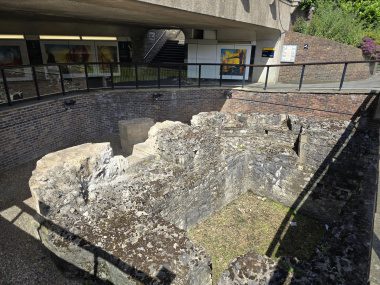London’s postern gates
As the conurbation of the City expanded beyond the walls, for residential, commercial or recreational use, the location of the road gates became inconvenient for many Londoners. For that reason, over time several postern gates were opened through the wall that allowed pedestrians to pass through.

These late 13th century remains of a postern gate were discovered during work in 1979 to create a pedestrian subway from Tower Hill tube station.
Tower Hill postern
Perhaps the earliest postern gate that was not part of one of the main gates was that at Tower Hill, adjacent to the moat of the Tower of London. The creation of the Tower of London in the 1070s and its gradual enlargement, together with the city wall, probably created a major obstacle for anyone wishing to pass out from the southeastern side of the City to the riverside beyond. The nearest gate was Aldgate, some distance walk to the north.
An early postern gate close to the Tower was demolished in 1190 when the Tower of London was enlarged by William Longchamp. The postern was rebuilt at the turn of the 14th century on the north side of the Tower moat. Some years later the structure slipped down the side of the moat and was rebuilt. Stowe wrote of it in the late 16th century: “by that part which remaineth, to have been a fair and strong arched gate, partly built of hard stone of Kent, and partly of stone brought from Caen in Normandy…and served for passengers on foot out of the east.” In 1667 Samuel Pepys wrote in his diary of passing through it. Its remains were discovered in 1979 and have since been preserved for all to see in the subway between the Tower of London and Tower tube station.
Christ Church/St. Bartholomew postern
To walk from Christ Church Greyfriars inside the City wall on the western side to St. Bartholomew’s Hospital outside the wall involved a longish walk to pass through Newgate. In 1553 the City of London arranged for a postern to be made through the wall between the two former friaries.
Little Winchester Street postern
A postern was created in 1636 opposite Little Winchester Street, in the wall between Moorgate and Bishopsgate for people wishing to walk out to that part of Moorfields. In 1755 it was demolished.
The Aldermanbury postern
By the 17th century Cripplegate and Moorgate had become congested with the number of people passing in and out. Therefore, in the middle of the century the City of London created a postern between the two, originally known as the Little Postern. It was located at the area of the City known as Aldermanbury and the gate later took on that name. It was described in the early 18th century as quite a handsome passageway. Yet the Aldermanbury postern seemed to create a nuisance and the local people of Aldermanbury petitioned for it to be removed. It was replaced by a new, wider gate opening on to Fore Street.
<Back to The City Wall and Gates of London
Sources include:
- Alan Brooke ‘Gates of the City of London’
- John Schofield ‘London 1100-1600’
- John Stow ‘A Survey of London’ (1598)


